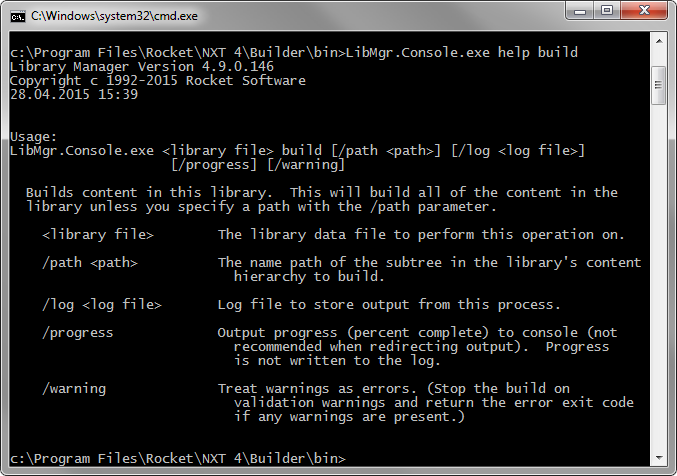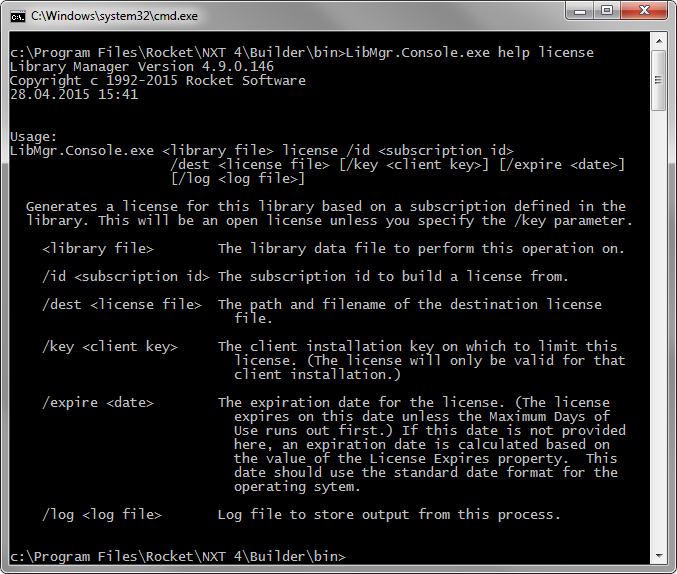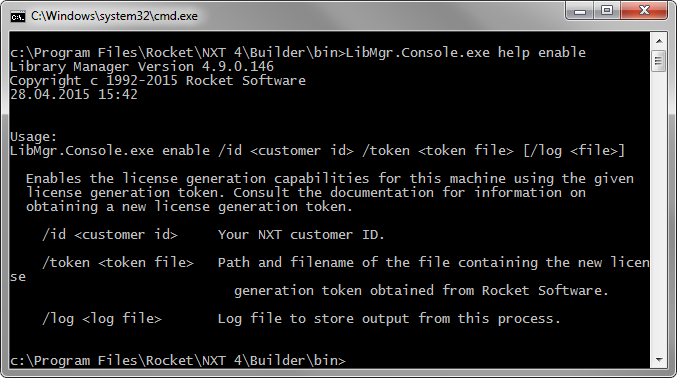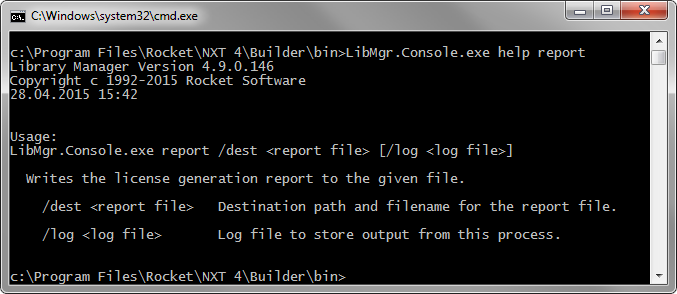
You can perform some Library Manager tasks from the command line using the
Library Manager console interface (LibMgr.Console.exe), which is
installed in the bin directory of the NXT Builder install
directory. The Library Manager console interface is intended for use in
situations when you want to do the following tasks without any user
intervention:
Figure 1 shows the usage summary of the build command for LibMgr.Console.
This command enables you to activate a build on your entire library or a
subtree of your library. You can also
build your library through the Library Manager GUI interface.

Figure 1. Usage summary for the build command
Table 1 shows a list of parameters for the build command.
Table 1. Parameters of the build command
| Parameter | Description |
|---|---|
build |
(Required) Tells the Library Manager to perform a content build operation. |
<library file> |
(Required) The name of the library definition file on which to perform this operation. |
/path <path> |
(Optional) Specifies the portion of the library content on which the build should operate. If specified, then the Library Manager builds all content for the given path and all of its descendants in the content hierarchy. If you do not specify this value, then the Library Manager builds all content for the library. This path must include the content root name from the library root. |
/log <log file> |
(Optional) If specified, then the Library Manager writes all output from the build process to the given log file. |
/progress |
(Optional) Enables you to view build progress from your console. The progress information is not recorded in the log file. The default setting is not to report this information to the console. |
/warning |
(Optional) Enables the LibMgr.Console utility to treat warnings as errors. This is similar to the Library Manager preferences setting. When the utility encounters a warning, it terminates the build process and reports the error exit code to the console. |
Figure 2 shows the usage summary of the license command for LibMgr.Console.
This command enables you to generate a license for your library based on a
specific
subscription you created with Library
Manager GUI application. You can also
generate a license through the Library Manager GUI interface.

Figure 2. Usage summary for the license command
Table 2 shows a list of parameters for the license command.
Table 2. Parameters of the license command
| Parameter | Description |
|---|---|
license |
(Required) Tells the Library Manager to generate a license that is based on the parameters that you pass. |
<library file> |
(Required) The name of the library definition file on which you want to perform this operation. |
/id <subscription id> |
(Required) Specifies the subscription (by its ID
property) that you want to generate a license for. You can find this ID value in the Properties
pane of the Subscriptions tab for the given subscription. For more information about subscriptions, see Subscriptions. |
/dest <license file> |
(Required) Specifies the path and name of the
license file (.publc) that LibMgr.Console will create. You may use
absolute or relative paths, or no path at all.If you only specify a file name, the utility will place the file in the LibMgr.Console directory ( ...\Rocket\NXT 4\Builder\bin). Relative
paths are relative to the LibMgr.Console directory.Minimally, you must provide a file name for the file with the extension of .publc.
If you do not use the .publc file extension for the license file,
NXT will not recognize the file as a license file, and thus, your end users
will not gain access to your content. |
/key <client key> |
(Optional) Enables you to create a client-specific license, rather than an open license, which is the default. This key is the client installation key that makes a license usable only by the specific client. |
/expire <date> |
(Optional) Specifies an expiration date of the license. The actual expiration date of the license is determined by this date or the Maximum Days of Use property of the subscription, which ever comes first. If you do not use this option, then the license will expire in accordance with the License Expires property of the subscription. Use the standard date format for your operating system. |
/log <log file> |
(Optional) If specified, then the Library
Manager writes all output from the build process to the given log file.
Minimally, you must provide a log file name. Absolute and relative pathing
rules for the /dest parameter apply here as well. |
/progress |
(Optional) Enables you to have the progress of the license generation viewable from your console. The progress information is not recorded in the log file. The default setting is not to report this information to the console. |
/warning |
(Optional) Enables the LibMgr.Console utility to treat warnings as errors. This is similar to the Library Manager preferences setting. When the utility encounters a warning, it terminates the build process and reports the error exit code to the console. |
The enable command enables the license generation capabilities for the machine by using the given generation token.

Figure 3. Usage summary for the enable command
Table 3 shows a list of parameters for the enable command.
Table 3. Parameters of the enable command
| Parameter | Description |
|---|---|
/id <customer id> |
Your NXR customer identifier. |
/token <token file> |
Path and name of the file that contains the new license generation token that is obtained from Rocket Software. |
/log <log file> |
Log file to store output from this process. |
Figure 1 shows the usage summary of the report command for LibMgr.Console.
This command produces a License Generation Report with the name and in the
location that you specify.

Figure 4. Usage summary for the report command
Table 4 shows a list of parameters for the report command.
Table 4. Parameters of the report command
| Parameter | Description |
|---|---|
/dest <report file> |
(Required) Specifies the file path and name for your License Generation Report. |
Copyright © 2006-2023, Rocket Software, Inc. All rights reserved.